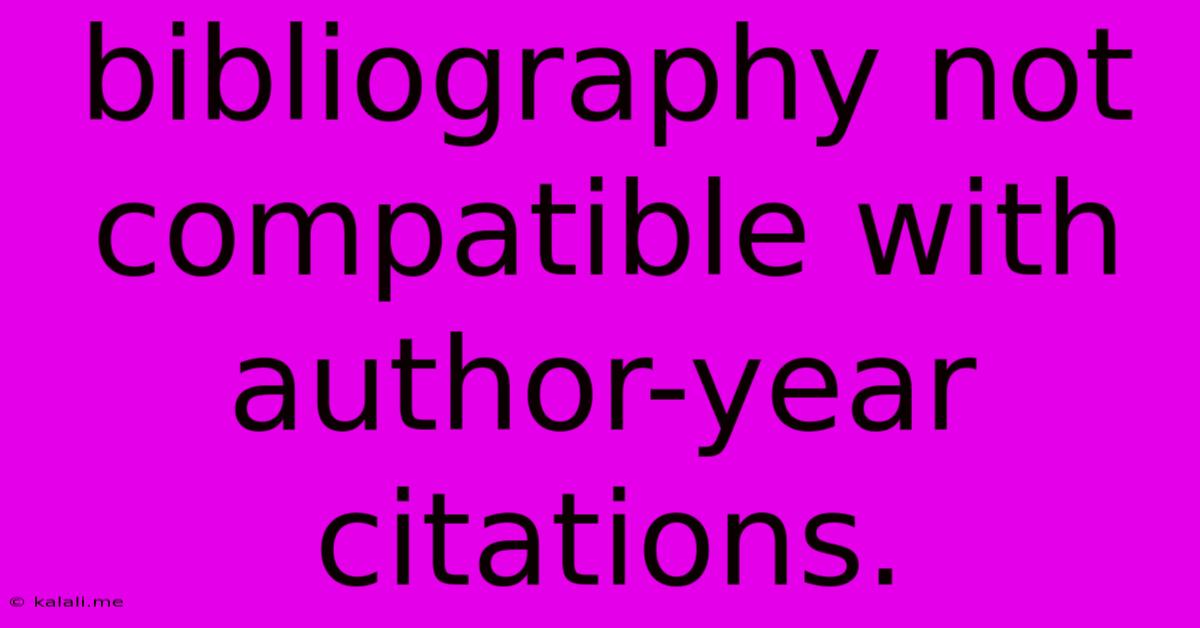Bibliography Not Compatible With Author-year Citations.
Kalali
May 24, 2025 · 3 min read

Table of Contents
Bibliography Incompatibility with Author-Year Citations: A Guide to Consistent Referencing
Choosing a citation style can feel like navigating a minefield. One common pitfall for researchers and writers is the incompatibility between a bibliography and author-year citations (also known as name-year or author-date citations). This article explores this issue, highlighting the problems it creates and providing solutions for maintaining consistency in your academic writing. Understanding this will ensure your work adheres to academic integrity standards and avoids confusion for your readers.
The Core Problem: Mismatched Systems
The core problem lies in the fundamental differences between citation styles. Author-year systems, like those used in the American Psychological Association (APA) and Modern Language Association (MLA) 8th edition (though MLA's use of parenthetical citations is slightly different), prioritize concise in-text citations focusing on the author's last name and publication year. The full bibliographic information is then relegated to a separate reference list or bibliography. Other styles, like Chicago style, use numbered footnotes or endnotes, linking directly to a numbered bibliography. Mixing these creates inconsistencies. Using an author-year citation with a numbered bibliography creates a disconnect; the reader has no immediate way to link the in-text citation to the appropriate source in the bibliography.
Consequences of Incompatibility
Using a bibliography incompatible with your author-year citations can lead to several negative consequences:
- Reader Confusion: The biggest problem is the confusion it causes for the reader. They struggle to find the full bibliographic information for the cited work. This disrupts the reading flow and undermines the credibility of your work.
- Lack of Academic Rigor: Inconsistent referencing practices detract from the academic rigor of your writing. It suggests a lack of attention to detail and can cast doubt on the reliability of your research.
- Plagiarism Concerns: While not directly plagiarism, the inability to easily trace sources increases the risk of accusations of plagiarism, especially if the reader cannot quickly verify your sources.
- Journal Submission Rejection: Many academic journals have strict guidelines about citation style. Submitting a paper with incompatible citation and bibliography styles is a surefire way to get your paper rejected.
Solutions and Best Practices
The solution is simple: ensure consistency. Choose a citation style that uses author-year citations and a corresponding bibliography format that aligns with it. Don't mix and match. Here are some key steps to achieve consistency:
- Choose a Style Guide: Select a reputable style guide (e.g., APA, MLA, Chicago) and stick to it meticulously. These guides provide comprehensive rules for both in-text citations and bibliographic entries.
- Use Citation Management Software: Tools like Zotero, Mendeley, or EndNote can significantly simplify the process. They automatically format citations and bibliographies according to your chosen style, minimizing the chance of error.
- Review Carefully: After completing your writing, meticulously review both your in-text citations and bibliography to ensure every source cited in the text is correctly represented in the bibliography and vice versa. Look for any inconsistencies or missing information.
- Consult Style Manuals: If you're unsure about a specific aspect of formatting, refer to the style manual directly. Many online resources and style guides are available.
Conclusion: Maintain Academic Integrity through Consistent Referencing
Avoiding the mismatch between your bibliography and author-year citations is essential for clear, credible academic writing. By carefully selecting a consistent citation style, utilizing citation management software, and diligently reviewing your work, you can maintain academic integrity and ensure your research is presented professionally and accurately. Remember that attention to detail in referencing reflects positively on the overall quality of your work. Invest the time to get it right.
Latest Posts
Latest Posts
-
How To Fix Rough Idle When Ac Is On
May 24, 2025
-
Equation Of A Plane From 3 Points
May 24, 2025
-
Bash Find Write Access To File
May 24, 2025
-
Arc Fault Breaker Tripping With No Load
May 24, 2025
-
In The Field Or On The Field
May 24, 2025
Related Post
Thank you for visiting our website which covers about Bibliography Not Compatible With Author-year Citations. . We hope the information provided has been useful to you. Feel free to contact us if you have any questions or need further assistance. See you next time and don't miss to bookmark.